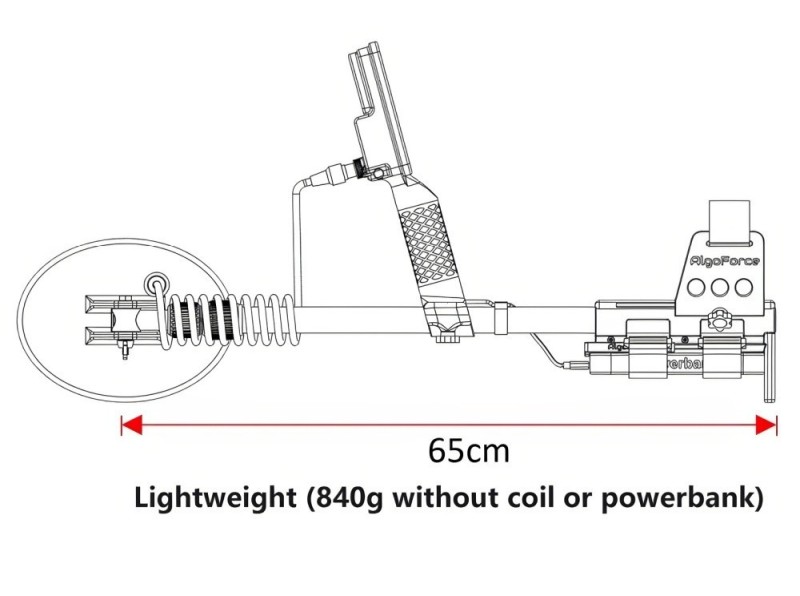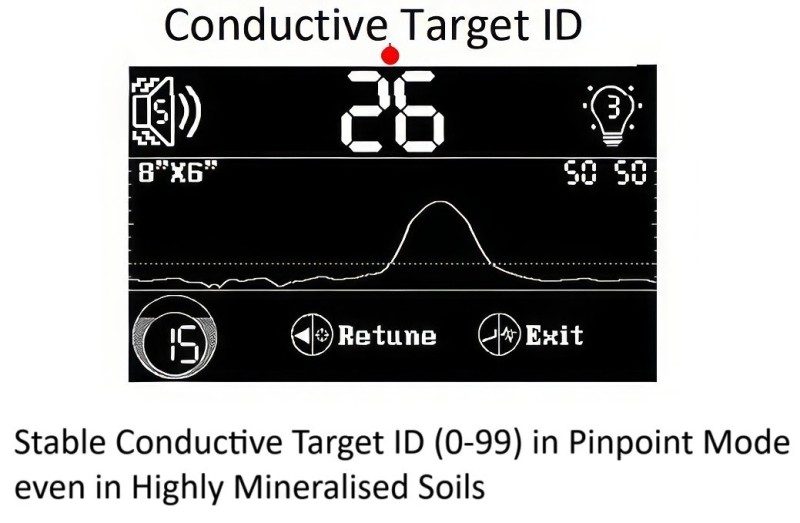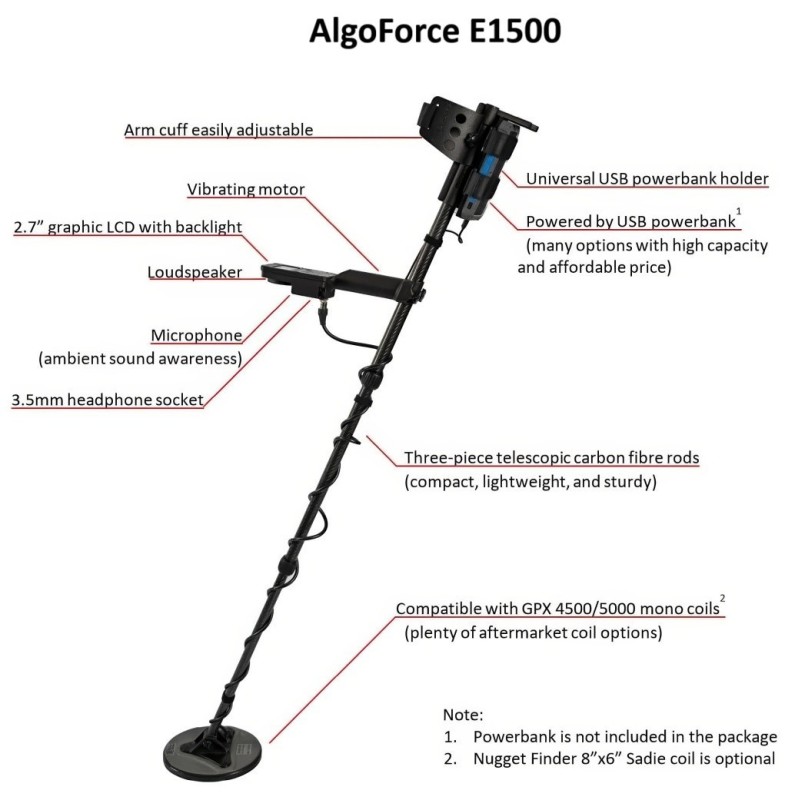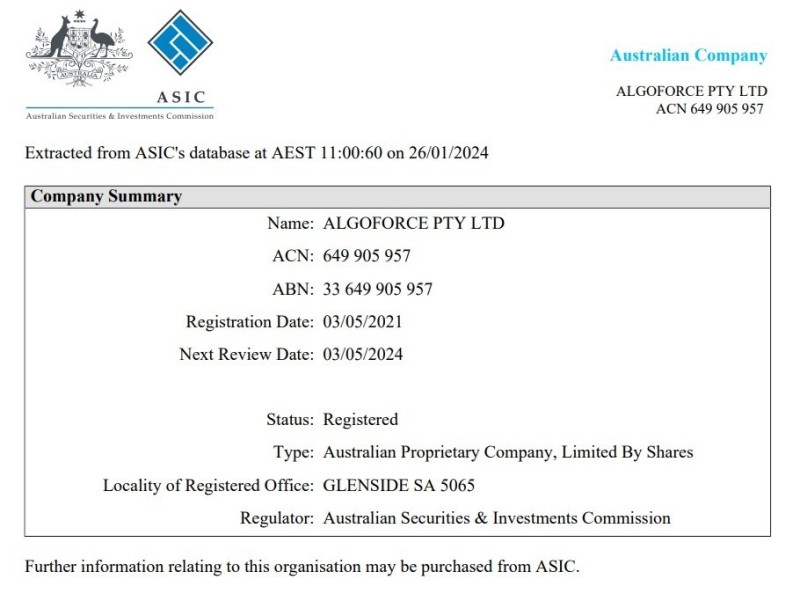-
Posts
19,680 -
Joined
-
Days Won
1,563
Content Type
Forums
Detector Prospector Home
Detector Database
Downloads
Everything posted by Steve Herschbach
-
Nowhere does AlgoForce refer to ferrous versus non-ferrous discrimination per se. It specifically refers to the Conductive Target ID - in other words, a measurement of how conductive the target is whether ferrous or non-ferrous. Most GBPI users have savvied to the fact that the high and low tones give a rough indication of target size. A hi or hi-lo tone usually means small or low conductive targets and a low or lo-hi tone usually means large or high conductive targets. You get ferrous either way, just small ferrous on one side and large ferrous on the other. However, in certain gold locations concentrating on hi or hi-lo tones only can be remarkably effective at cherry picking gold nuggets out of a nail pit. Most gold I find almost always gives a hi-lo tone. Minelab employs a method where targets blank if ferrous, and Garrett the target grunts if ferrous. What makes the AlgoForce different is instead of the "this or that", "yes or no" answer of two categories you get a full range indication, which with experience should lead to more nuance in what can be dug and what can be ignored. For more details on how pulse discrimination works see my long analysis at the thread below....
-
Welcome to the forum. All I can say is skip the Gold Bug Pro as the Time Ranger is literally the same detector but with more features for a lower price. Defining feature between it and the Kruzer is the Kruzer is fully waterproof.
-
OK, now that WOULD be magical. It actually could have limited use. Like here in the states you will have a place where a person with a .22 rifle went nuts shooting at stuff. Little cartridges everywhere. They have a consistent id and you can ignore them. Of course a nugget that read like one would be missed, but odds are most nuggets would read as something else. But in general the best we nugget hunters can hope for is decent ferrous discrimination, and even it always comes with risks. When in doubt, dig it out!
-
??????????????????????????????? It is to help tell gold from nails and other ferrous trash.
-
New thread please. Refer to zillions of threads about old SD GP and GPX modded machines and GPZ 7000 threads, some quite recent. There are plenty of deep seeking options but this thread is for people interested in this detector, not whatever Minelab it is that you all are wanting.
-

AlgoForce E1500 And Pi Discrimination
Steve Herschbach replied to Steve Herschbach's topic in AlgoForce Metal Detectors
More on static non-motion. It is all about the detector autotune function. Before autotune you had a fixed threshold and any motion of the machine affected that threshold, calling for constant manual retuning, usually via a threshold reset button. Then autotune replaced that button, with machines constantly automatically trying to bring the threshold back to the preset level. If you hover over a target it disappears. The White's V/SAT was innovative in that it gave you the ability to vary the retune rate via "Variable Self Adjusting Threshold". It is the all metal version of reactivity. I go into the subject and it's history in great detail in the article below. PI went though a similar evolution from manual tuning to autotune threshold as anyone can see fast if you simply stop the coil over a target. Most PI detectors have no pinpoint no-motion mode at all. -

AlgoForce E1500 And Pi Discrimination
Steve Herschbach replied to Steve Herschbach's topic in AlgoForce Metal Detectors
Static means non-motion, and if you are thinking normal motion mode detecting it is a fatal flaw. All detectors sold today work on a motion mode principle where they need to be in motion to detect. Why did they not see the obvious - make it the pinpoint mode, which are static / non-motion modes? Another mystery to me but in any case it looks to be that is what this machine is doing. As far as patents these days it reveals your method and encoding in firmware gives better protection in some cases. Or it is based on something Dave patented and expired already. Whatever, as long as it works. I hope. I am sure it will have limitations of some sort. There always is. -
Got ya. I guess it just remains to be seen if that is a problem that needs a solution.
-
Just curious. If mono in general detects better than DD, and if you can get discrimination with a mono coil, what is it that a person needs a heavier DD coil for?
-
Hi Jason, yeah, lots to get excited about here. I hear what guys are saying about the focus on small gold, but we need a reality check here. The fact is large gold detection capability hit a sweet spot back with the SD2200D and piles of big gold came out of the ground over 20 years ago. Big nuggets despite what people think are not usually hard to find. Just the opposite, and often it is just a matter of being first over it. Massive nuggets were dug just inches deep. It is the nature of how desert placers form. They tend to be shallow surface deposits. So the dream lives on of having a machine that finds these imagined really large but really deep nuggets. A sad reality many do not want to believe is that they simply do not exist in most locations. Yes, they do exist. I am not saying they do not. But the vast majority that did were easily detected, and in many locations bedrock depth or other limitations means there is nothing big lurking deeper down. What does exist is huge volume of the smaller nuggets, especially in highly mineralized ground. The SDC 2300 was a big hit and that despite being a clunky ergonomic coil limited mess, because it does one thing really well. It hoovers up small gold with minimal controls. If you want to sell detectors you want people who buy them to find gold, and promising people multi ounce nuggets at depth is a pipe dream for most people that is never, and I mean never going to happen. But if you give a person a good machine capable of hitting tiny gold they will find gold and keep at it. And if they keep at it long enough, they just might be the first person to get their coil over a 1 ounce nugget everyone else missed. Not because it was deep. But because they took that little Sadie coil and shoved it in every nook and cranny they could find where bigger coils can't go. I'll bet more large nuggets exist in those places than at extreme depth. In between roots and in the boulder patches. I love hunting nooks and crannies and this machine with a Sadie coil will be my new sniping machine. Check back at the end of 2024 and we will see if I was crazy or not.
-

AlgoForce E1500 And Pi Discrimination
Steve Herschbach replied to Steve Herschbach's topic in AlgoForce Metal Detectors
-
Read that article I just posted - I am getting one asap, love it, right up my alley, going to have fun with this one for sure!! Go FCC go!!!
-
I am shocked, stunned, and amazed that everyone seems to be skating past that this machine is offering the first 0-99 conductive target id ever offered in a real PI.
-
We have a new player on the field in the form of AlgoForce and their new E1500 detector. One thing that is not getting as much attention as I would expect from a PI - full range target conductivity id. From the owners manual: "For experienced PI users accustomed to estimating nugget size from audio cues, the AlgoForce E1500 can also help to estimate size or conductivity through its stable conductive target ID (0-99), even in highly mineralized soils. High single frequency VLF detectors typically struggle with signals on wet ocean sand, where PI detectors are far more capable of detecting through the salt mineralization. Capitalizing on its UltraFine pulse induction technology and stable conductive target ID (0-99), the AlgoForce E1500 excels on the beach, proving to be a versatile tool for searching fine jewelry, coins, rings, and other treasures." (Emphasis added) The discrimination feature kicks in when using the pinpoint mode. Again, from the manual: VIII. Pinpoint detected target (if needed) Enter the Pinpoint UI by pressing the Left/Pinpoint button in the Main Detection UI. In the Pinpoint UI, adjust Sensitivity with the Minus or Plus button. To retune the detection threshold due to ground variation or temperature drift, press the Left/Pinpoint button as needed. Perform Auto GB if needed by holding the Right/Auto GB button. Return to the Main Detection UI by pressing the Return/Auto FS button. Pinpoint is a non-motion mode where the coil doesn't have to move to indicate a target. The detection signal gets stronger as the coil approaches the target, causing the audio (if audio output is on) or vibration (if vibration mode is on) to intensify. The Conductive Target ID (0-99) displayed in the Pinpoint UI remains stable even in highly mineralized soils. A higher number indicates a larger or more conductive target. To obtain an accurate target ID, it is recommended to follow these steps: Move the coil away from but close to the target. Ensure the coil is resting on the ground surface and press the Left/Pinpoint button to retune. After that, slide the coil on the ground surface until the target is positioned just below the center of the coil. The target ID is also useful for assessing the target's shape. If the target ID fluctuates significantly when the coil is moved slightly off but still above the target, it likely indicates an irregularly shaped target, such as a bottle cap or a nail with a large head. Target conductivity is not the same as VLF discrimination in that both ferrous and non-ferrous are conductive. Stuff that is small or low conductive reads low numbers and stuff that is large or high conductive reads high numbers. Ferrous can read anywhere depending on various factors, so the usefulness of the system largely depends on the nature and mix of targets you are working with. Nowhere does the AlgoForce manual refer to ferrous versus non-ferrous discrimination. It specifically refers to the Conductive Target ID - in other words, a measurement of how conductive the target is whether ferrous or non-ferrous. Most GBPI users have savvied to the fact that the high and low tones give a rough indication of target size. A hi or hi-lo tone usually means small or low conductive targets and a low or lo-hi tone usually means large or high conductive targets. You get ferrous either way, just small ferrous on one side and large ferrous on the other. However, in certain gold locations concentrating on hi or hi-lo tones only can be remarkably effective at cherry picking gold nuggets out of a nail pit. Most gold I find almost always gives a hi-lo tone. Minelab employs a method where targets blank if ferrous, and Garrett the target grunts if ferrous. The Garrett method is preset, the Minelab method can employ a variable control depending on the model. What makes the AlgoForce different is instead of the "this or that", "yes or no" answer of two categories you get a full range indication, which with experience should lead to more nuance in what can be dug and what can be ignored. PI discrimination is not the same as VLF discrimination. There are different aspects to it that require a savvy operator. There are a lot of half truths and incorrect statements tossed around by people who don't know much on the subject. One of the most common claims I hear is that PI disc only works at shallow depths, and that the things you have to do to implement it give up the extra depth that is the reason for using a PI in the first place. This is based on some versions of PI discrimination and so can be true, but also reflects that the person making such statements is not well versed in all aspects of the subject. You can indeed discriminate to full depth with a PI, and in fact that is the only way I have been doing it for almost 20 years now. For more details on how pulse discrimination works see my long analysis at the thread below. No, it’s not VLF discrimination, but you’d be amazed what good PI operators can do with the capability they do have. We have a winner in the Under 4 Pound, Under $2000 GBPI Challenge! AlgoForce E1500 Specifications and User Manuals Visit the new AlgoForce Metal Detector Forum
-

Benefits Of Controversy
Steve Herschbach replied to JCR's topic in Metal Detector Advice & Comparisons
No surprise at all. Job one is to attract eyeballs by either being entertaining or being controversial. Being first also beat being right. Being knowledgeable is low on the list when it comes to getting an audience. Some of the most ignorant people making the wildest claims can attract the widest audiences in this day and age. -

Early Field Review Of AlgoForce E1500
Steve Herschbach replied to PhaseTech's topic in AlgoForce Metal Detectors
Totally agree, could not have said it better myself! -

Early Field Review Of AlgoForce E1500
Steve Herschbach replied to PhaseTech's topic in AlgoForce Metal Detectors
QED was the right idea but poorly executed so it missed the bus and comparing the AlgoForce to the QED does it a disservice I think. And "tiny gold only" is nonsense. Of course it will detect larger gold. What is the GPX 6000 but an overpriced "tiny gold detector" and I'll point out the popular SDC 2300 as another "tiny gold detector." Yet the SDC has surprising punch on larger gold. AlgoForce is simply being smart in emphasizing what the vast majority of people are really going to be detecting these days - smaller nuggets, not one ounce plus gold. I think it might be some of you who are surprised. It may not be what people who only care about cutting edge performance want, granted. But the Fisher Gold Bug Pro sold in huge volumes due to the simplicity of its ground grab system and the Monster also proves that regular folks want ease of operation. If this proves to be the Gold Bug Pro of the PI world they will sell piles of them. Most users here have little understanding of the wider retail world and the market that exists for a machine that has the right balance of features at a price normal people can afford. The pricing of machines like the 6000 and 7000 is completely absurd and impossible for far more people than the well to do members of this forum appreciate. Yeah, I can pop for a GPZ 7000 at the drop of a hat, but trust me, a minority of people are in that boat. The market for a detector like this is huge and has been waiting for the right company to open it up. I expected it to be Nokta but AlgoForce may have beaten them to the punch. Or not. We will see, but it will be a very interesting year or two ahead of us no matter what. -
Nice looking machine.
-
I agree and so it is done. Seven years in the making but we may finally have a winner worthy of the title.
-
So here we are seven years after I issued my challenge. I had no idea we would be waiting this long, though with technology it has always been a matter of when, not if. Garrett was my main hope but instead of quickly repackaging an ATX to take the prize years ago, they re-engineered the machine to win on weight but came in at twice the desired price. It was their game to lose and they lost it. My next hopes have been pinned first on Nokta and second on Fisher. Fisher has not given up on PI, at least not yet. The following news might change that. Out of the blue we get a new company with a new detector, and it is ready to go right now! The AlgoForce E1500 has just been announced, and it looks like the detector that might finally take the prize. Priced at AUD $2275 or about U.S. $1500 but comes without a coil or power pack. It can use Minelab SD/GP/GPX coils and runs off any standard USB power brick. The detector without coil or power pack weighs 840 grams or 1.9 lbs. A Nugget Finder 6x8 Mono "Sadie" coil weighs 500 grams. I'm going to assume a 500 gram power pack to get at least some semblance of balance, and if so that puts us right at 4 lbs. A larger power pack or battery or both could easily add another pound, but 4 lbs is possible. Now the price at $1500 U.S. plus a Sadie coil sold in U.S. for $250 leaves plenty of room for a battery and or shipping to come in at or near the $2000 target price. So folks, we may have a winner. The fact a longtime Minelab engineer is behind all this lends real credence to it being a performer. If it simply matched the Axiom on performance it will still blow it away for price and features, especially in Australia where the Axiom is overpriced compared to the U.S. Anyway, I'm going to get one and find out. I have been an avid follower of metal detecting technology for over 50 years, and as a nerd tech type I always knew what I wanted and what was possible. The Minelab Equinox finally ticked off my desired VLF wish list to the point where I really didn't care what came after. Mission accomplished. But PI has been frustrating, and I was starting to wonder if I'd live long enough to see this happen. But if this is for real, and I think it is, it marks the dawn of a new age in PI detectors, of power, ergonomics, and affordability. Is the E1500 the Equinox of the PI world? If so it will set a new standard of what people expect and good luck selling detectors for over $8000 going forward. I think that dam just burst, thanks to AlgoForce. AlgoForce E1500 Specifications and User Manuals Visit the new AlgoForce Metal Detector Forum 65 cm or 25.6 inches
-
-
They may be seeking U.S. dealers and usually you limit dealers to selling only in their own country or region, so not surprising. But what is best is none of that vaporware new detector coming wait forever routine we have been saddled with as of late.
-
From https://phasetechnical.com.au/detectors/ Minelab SDC 2300 AUD $4565 GPX 5000 AUD $5499 GPX 6000 AUD $8999 From https://www.prospectorspatch.com.au/product/garrett-axiom-metal-detector/ Garrett Axiom AUD $7199 And now we have the AlgoForce E1500 at AUD $2275. If it is even just a match for the Axiom it is a game changer, and if it is better well them it is a GPX 6000 for 1/4 the price!
-
This is obviously out of date now but looks like the real deal for sure. https://www.zoominfo.com/p/Ruifeng-Huang/-1621431172 Ruifeng Huang is (was) a Senior Signal Processing Engineer at Minelab based in Mawson Lakes, South Australia. Previously, Ruifeng was a Research Scientist at National University of Singapore. Ruifeng received a Bachelor degree from North China Electric Power University and a Master of Engineering from North China Electric Power University.









